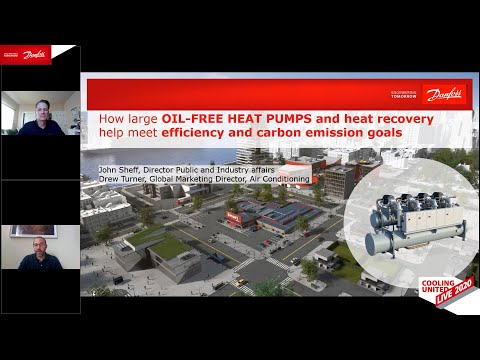Oil-free heat pumps and heat recovery—meeting efficiency and carbon emission goals | CU Live | AC

Hi everybody my name is John Sheff, I'm the director of public and industry affairs at Danfoss and I am thrilled to be joined today by Drew Turner our director of global marketing for air conditioning also at Danfoss, and we're going to be talking today about large capacity commercial and industrial heat pumps utilizing Danfoss oil-free technology. We'll be going over the trend towards heat pumps for both standalone buildings and integrated into district heating systems, what's driving that trend and specifically the use of heat recovery water to water heat pumps. We'll be discussing a few of the applications and their characteristics going over the Danfoss component technology that's utilized in those applications and finally ending with a testimonial from one of our OEM customers on why they see the use of oil-free technology in water water heat pumps as a significant opportunity moving forward so let's get started. Drew, why are we seeing this shift in how buildings are heated from fossil fuel fire systems to more electrically driven heat pumps? Yeah thanks John. It's really critical to start with when you talk about heat pumps to start with a trend driving it. The main issue that you see today with heat pumps or, excuse me, with the heating provided today is that it's provided by a fossil fuel source. And that's over
80 percent of the heating that's provided today is provided by fossil fuel sources. And the issue with it is that it's inefficient so first of all, first and foremost is it it's inefficient. The best efficiency you can achieve with a fossil fuel source heating system is a roughly a COP of 1, and it also causes issues with the greenhouse gases that are generated as a result of burning those fossil fuel sources, and then also locally where those are being burnt with the generation of sulfur dioxide and nitrogen oxide. So it's a combination of factors that are really driving it and first and foremost is the efficiency and resulting co2 emissions. As opposed to that, as opposed to that fossil fuel source heating, you have heat pumps.
Heat pumps and with this example shown here of an air-to-water version you can generate that heat at about three and a half times the efficiency of that fossil fuel source, and that, even taking into account the lower efficiency using this as a baseline, fossil fuel source generation that's driving the electrical power utilized by the heat pump along with the roughly 10% losses from transmission and distribution that still results in uh approximately a 35% operating cost reduction and then a 60% emissions reduction. Also coming into that is the fact that related to the efficiency comparison that I talked about earlier which is at the design efficiency, is that these heat pumps get better more efficient at cart load conditions so as you go off design conditions that heat pump is going to operate more efficiently. And that's as opposed to the fossil fuel source heating including condensers boilers and furnaces which do not get more efficient at part load or in the case of a condensing boiler gets slightly more efficient. With the heat pump you get significantly more efficient. So electrification of heating systems, moving to heat pumps. leads to significant improvement in operating efficiency and you touched on this a little bit but let's go into a little more detail what is the potential to reduce emissions by making this transition? Yeah it's really critical because the this is the number one factor, you know the efficiency comparison is critical, but the number one factor that's really driving the growth of heat pumps and the opportunity for heat pumps is that you need to if you're going to decarbonize heating you need to have a more efficient solution but you also need to decarbonize the energy source utilized for them. So it's an incremental opportunity of the efficiency of the heat pump
and then the decarbonization of the power generated to be utilized by the heat pump. And how you do that is of course replacing that combined cycle in the example shown on the previous slide replacing that combined cycle natural gas plant with renewables. Most prevalent today and what's accelerating in terms of growth is the use of wind and solar, and that's what really generates the decarbonization potential the additional decarbonization potential of implementing heat pumps. And that's what we show on the next slid,e is that potential. So with the heat pumps and the
implementation of them as you integrate in more renewables into that power generation portfolio, that decarbonization potential increases. What we've seen in the last few years is about one percent on average about one percent per year growth of the use of renewables in the U.S.. You also see that same roughly one percent growth of renewables in Europe but they're about 10 percent ahead of the U.S. so the decarbonization potential and this is the main point as you implement in more renewables from about the 20 percent that the U.S. is at today in the 30 that on average the European market is at today that increase increases the corresponding carbon emissions reduction from implementing or decarbonizing heating by implementing heat pumps. So as renewables become an increasingly large part of the grid, the carbon reductions uh will compound from increase in efficiency and the phasing out of fossil fuel generation.
How are other regions around the world handling this transition and how is it different from the approach in the U.S.? That's a really good question and it's a really good subject to get into what we see in Europe is that district energy in general, but especially district heating is has become more prevalent district heating actually originated here in the u.s back in the edison days roughly 120 years ago but since that time it's evolved in the European market to where they're very efficient at generating heat with a district energy grid serving multiple customers from centralized plants what's shown here is an example of that grid so in this example it also shows the power generation coming in to the district heating grid and as well a district cooling grid that can be operated or implemented in parallel to that district heating grid. That is pretty rare today that combination of the two but we see it more we see the growth of it more happening in the future. With that district heating grid what you see is that there's generally a combination of centralized heat pumps and distributed heat pumps and I'll come come back to more of that later but specifically with the central, or excuse me, with the district heating grid you have the centralized heat pumps or distributed heat pumps serving a supply and return line. So that district heating system has that as shown here with
the red line and yellow line the district heating supply and district heating return line going to each of the customers in that grid or in that network. And that piping is generally a combination of that distributing supply and distributing return in a single insulated pipe. And with those networks, with those district heating networks you see a combination of different types of networks. First of all with the power, or excuse me, with the heat generation sources serving them and that can be a combination of wasted waste energy co-generation and or heat pumps. And what we see is that those are incremental those heat sources are incrementally being replaced by heat pumps. And with the thermal heat storage what you do is you address the disconnect that is coming or that has happened in several cases from the supply to the distribution or the demand side. So as you
integrate in more renewables because the wind only blows when it wants and the sun only shines when it wants you create that disconnect between energy supply and energy usage. A district heating grid based on the combination of factors of the thermal flywheel effect of the loop size itself along with the options that it creates for integrating thermal heat storage is a critical factor. But it also that district heating grid and this is why you see growth of it in Europe and we're projecting that it's going to happen significantly in other regions as well it implement, or it creates, the opportunity for multiple heat recovery opportunities to then boost up with the heat pump to supply to the district heating network. With those networks
you see a wide variety of them including those shown with the line network the mask network or some combinations of those. Yeah and so clearly these networks Drew give the opportunity for really high efficiency sharing resources utilizing heat recovery innate thermal storage adding more storage um and so the opportunities for efficiency are really there, but traditionally these district networks have relied on fossil fuel power generation right? That is correct and that that's the issue and, that's the well or the opportunity that we see today, what's happening today is that those heat sources are being replaced by those former high emissions heat sources such as waste energy and co-generation plants and other heat sources and boilers and furnaces are being replaced incrementally by heat pumps. And when they do that they can do it with a combination of two different methodologies or two different methodologies or a combination of them, and those include centralized district heating heat pump plants or decentralized district heating heat pump plants focused on the heat recovery the distributed heat recovery applications that can be utilized for them. Specifically with the centralized district heating heat pump plants what we see is that they're generally in the 20 to 40 megawatt range, and that the heat recovery water temperatures utilized for them are in the zero to 10 degrees celsius range. They're generally utilizing some form
of centralized heat recovery heat source such as ambient water or seawater and with that that's what drives that lower temperature heat recovery heat source an important side note here is: any heat pump is going to get less efficient the more work it has to do. That's as opposed to those higher emission heat generation sources such as a co-generation plant. Co-generation plant or a boiler or a furnace, it doesn't care what heat gen temperature it generates it's going to be at about the same efficiency but a a heat pump is going to get about two percent less efficient for each 1k differential increase that it has to do. So it's critical to operate with higher temperature heat recovery heat sources if possible. That in turn is driving the focus on decentralized heat
recovery heat pump plants, those are generally in the 2 to 10 megawatt range but more critical is the fact that they recover that heat at about 10 to 20 degrees celsius or at a higher temperature than those centralized resources. *inaudible* distributed systems and why are utilities moving more in that direction? Yeah so with the distributed systems they're moving more in that direction because of that higher temperature and higher efficiency that is possible with it. So with a distributed model you have a combination of heat recovery opportunities with industrial process, data center, food retail hospital just as a few examples. All of those heat sources though are providing a higher heat recovery heat source temperature but also providing cooling to the application both of those mean a more efficient system. That's why we see that they're now focusing more from those centralized heat district energy heat pumps to more of the distributed model. With the distributed heat pumps what we also see is that there's the opportunity
to optimize the system to those applications and actually this is true for the centralized as well but the higher efficiency that we talked about that's possible with the distributed model, it is also optimized or increased by optimizing the system architecture and system design for it. With these distributed distributic energy or district heating heat pumps what we figured out is that a some combination of our medium pressure or medium lift optimized compressor designs implemented in a heat pump in combination with a high lift, or high differential temperature optimized heat pump, or compressor designs in a heat pump provides that optimal efficiency and that's in a series-series counter flow arrangement with the heat pumps so for this example shown here showing the district heating return coming back at 40 degrees celsius and supplying the cooling to the industrial process facility at one degree celsius, and then supplying the district heating system at 67 degrees celsius this stage series-series counterflow oper architecture with a combination of those medium pressure optimized and high ,or high lift , optimized compressors is the optimal efficiency solution for that. And so Drew, why is combining heating and cooling into the same system so much more efficient and much more cost effective? Absolutely it's a critical factor. As i mentioned with the heat recovery temperatures what it drives is a higher heat recovery temperature, but the reason it drives a higher temperature heat recovery is because you're also providing cooling to that facility so whether it's a food retail facility or a data center or an industrial process it's recovering heat off of the cooling process. And we call this symbiosis, right,
the natural progression of electrification and as we see it electrification of heating is the realization that both cooling and heating are just moving heat when you realize that you integrate in those systems and you stir both the cooling load at that distributed load and then you recover the heat to the district heating system but you get the benefit of both that's the major point, You get the combined benefit of the cooling provided to the industrial process as the example and then the revenue stream also of supplying the heat to the district heating system. That in turn of course drives higher efficiency because you get the combined capacity of the cooling with the heating and then all of that divided by the power draw of that heat pump that's as opposed to the heat pump just providing the district heating so with more of the centralized model you're going to just get the benefit of that heat pump providing heating to the district heating system. And as opposed to that with the combined cooling and heating you get significantly greater efficiency as shown here. The other point that we like to make with these applications is that our compressors are optimized to those designs so there's a number of reasons that we see the water to water heat pump design providing both cooling and heating to an application as the best solution and some combination of our compressors implemented in the heat pumps to serve them, but it's also our main focus because that's the main capability that we have today. So this slide shows an example
of our operating map for the new high lift compressor designs and it shows the specific operating point for that district heating heat pump application recovering or getting the heat from that cooling operation returned at 16 degrees celsius and returning it to, or excuse me, the source temperature coming out of the evaporator of that heat pump going to that industrial process at 15 degrees celsius or 16 degrees celsius and then coming in suction to the compressor at 15 degrees celsius that in combination with the y-axis that shows the discharge temperature coming out of the compressor. The main point here is that we can provide those higher district heating temperatures such as around 67 degrees celsius hot water with these compressors today. That's as opposed to the next slide which shows our that we can do air to water heat pumps today with these new higher lift higher differential temperature capability compressors, but you're going to be somewhat limited in the heating temperatures that you can provide.
That's based on a combination of a number of factors related to the centralized versus decentralized heat pump issue that i was talking about earlier. If you're recovering heat from seawater or from air it's in general going to be at a lower temperature source than if you're recovering it from the cooling of an industrial process or a data center. And this example shows that. That if you're recovering heat from the air and it's operating at a
on a cold day at zero degrees celsius you'll have that lower heat transfer efficiency of an air to refrigerant coil driving that 7k differential to a lower temperature discharge temperature capability of around 52 degrees celsius on the high side and then that in turn enables about 50 degrees celsius on the hot water side so this is the other reason that we see water to water heat pumps as the best opportunity and specifically for this technology because you're going to be somewhat limited and that's true for most technologies as well you're going to have some limitations on that capability for the lower ambience and the air-to-water version. So speaking of technologies and you touched on the compressors already drew but um can you talk a little bit about what components Danfoss offers for these applications? Yeah and absolutely thank you for the question, because I already talked enough about the compressors you know we have a broad portfolio of oil-free Turbocor compressors for these applications but we also have a broad and expanding portfolio of other components and in the end what it drives is about 50 to 70 percent of the total value of the heat pump that we can provide ultimately Danfoss does not build the heat pumps we build the components that goes into the heat pumps but the broad portfolio includes, a broad and expanding portfolio includes, electronic controls, sensors and system protections and drives filter drives sight glasses solenoid valves and heat exchangers but the critical note here is that in addition to the broad portfolio that we have today we also design, test and optimize these to the applications that we're utilizing them in. Whether it's a heat pump application or a chiller application etc., the main point that we like to make is that not all components that can be used in an oil-free system or any chiller system for that matter are the exact are the same, that Danfoss designs tests and optimizes them to the specific application to make sure that they're going to provide the best reliability and the best efficiency. Yeah i think that's a great point I mean we are a component uh supplier but we understand how all these components work together in specific applications and so we really are a partner for our OEMs and and we'd like to work with them closely great point there. Well thanks Drew I appreciate your time,
this was a great discussion and I think it's a relevant one because we're definitely going to see this trend continue as we move into the future. And I'd like to thank everybody out there for joining us for this presentation. We're now going to move into our Q&A session in a dedicated virtual room if you want to ask a question please click the link our moderators are sharing in the public chat and we'll see in a moment. Thanks again, bye.
2021-01-29 12:14


